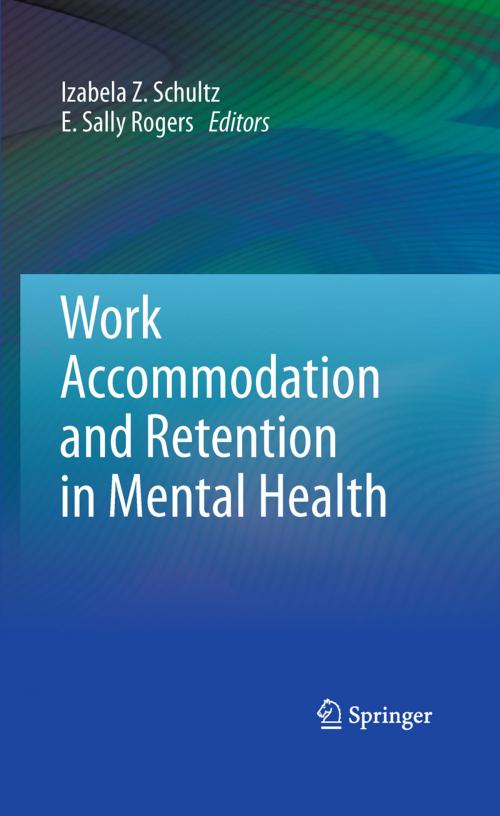Work Accommodation and Retention in Mental Health
Nonfiction, Health & Well Being, Medical, Specialties, Occupational & Industrial Medicine, Psychology, Applied Psychology| Author: | ISBN: | 9781441904287 | |
| Publisher: | Springer New York | Publication: | November 16, 2010 |
| Imprint: | Springer | Language: | English |
| Author: | |
| ISBN: | 9781441904287 |
| Publisher: | Springer New York |
| Publication: | November 16, 2010 |
| Imprint: | Springer |
| Language: | English |
Growing interest in the field of mental health in the workplace among policy makers, clinicians, and researchers alike has been fueled by equal employment rights legislation and increasing disability statistics in mental heath. The importance of addressing this topic is underscored by the fact that depression now ranks second on the hierarchy of occupational disabilities. The problem is compounded by a host of factors, including major difficulties in job retention and productivity experienced by persons with mental health disabilities; younger age and higher education of persons with mental health problems; and labor shortages and an aging workforce in many industrialized countries. In addition, particularly in the United States, the vocational needs of army veterans returning from duty with mental health disorders require system-based solutions and new rehabilitation approaches.
The pressure created by these powerful legislative, societal, and economic forces has not been matched by the state of evidence-based practices in the field of employment retention and job accommodation in mental health. Current research evidence is fragmented, limited in scope, difficult to access, and adversely affected by the traditional divide between the fields of psychiatry and psychology on one hand and interdisciplinary employment research and practices on the other. As a result, policy makers, employers, disability compensation systems, and rehabilitation and disability management professionals have been left without a critical "how to" evidence-informed toolbox for occupational practices to accommodate and retain persons with mental health disabilities in the workplace. Currently, no single source of knowledge and research evidence exists in the field that would guide best practices. Yet the need for workplace accommodations for persons with mental health disabilities has been growing and, based on epidemiological trends, is anticipated to grow even more in the future. These trends leave physicians, psychologists, occupational therapists, vocational rehabilitation professionals, disability managers, human resource professionals, and policy makers poorly prepared to face the challenge of integrating and maintaining persons with mental health disabilities in the workplace.
The aim of the Handbook is to close the gap between the needs of the professionals and networks that work with or study persons with mental heath disorders in an employment context and the actual knowledge base in the field. The Handbook will be written in language that can easily be understood by readers representing a multitude of disciplines and research paradigms spanning the mental health, rehabilitation, and employment fields of inquiry. The Handbook will contribute an integration of the best quantitative and qualitative research in the field, together with experts’ consensus, regarding effective work retention and accommodation strategies and practices in mental health. The book will consist of five major sections, divided into chapters written by recognized experts in these areas.
Growing interest in the field of mental health in the workplace among policy makers, clinicians, and researchers alike has been fueled by equal employment rights legislation and increasing disability statistics in mental heath. The importance of addressing this topic is underscored by the fact that depression now ranks second on the hierarchy of occupational disabilities. The problem is compounded by a host of factors, including major difficulties in job retention and productivity experienced by persons with mental health disabilities; younger age and higher education of persons with mental health problems; and labor shortages and an aging workforce in many industrialized countries. In addition, particularly in the United States, the vocational needs of army veterans returning from duty with mental health disorders require system-based solutions and new rehabilitation approaches.
The pressure created by these powerful legislative, societal, and economic forces has not been matched by the state of evidence-based practices in the field of employment retention and job accommodation in mental health. Current research evidence is fragmented, limited in scope, difficult to access, and adversely affected by the traditional divide between the fields of psychiatry and psychology on one hand and interdisciplinary employment research and practices on the other. As a result, policy makers, employers, disability compensation systems, and rehabilitation and disability management professionals have been left without a critical "how to" evidence-informed toolbox for occupational practices to accommodate and retain persons with mental health disabilities in the workplace. Currently, no single source of knowledge and research evidence exists in the field that would guide best practices. Yet the need for workplace accommodations for persons with mental health disabilities has been growing and, based on epidemiological trends, is anticipated to grow even more in the future. These trends leave physicians, psychologists, occupational therapists, vocational rehabilitation professionals, disability managers, human resource professionals, and policy makers poorly prepared to face the challenge of integrating and maintaining persons with mental health disabilities in the workplace.
The aim of the Handbook is to close the gap between the needs of the professionals and networks that work with or study persons with mental heath disorders in an employment context and the actual knowledge base in the field. The Handbook will be written in language that can easily be understood by readers representing a multitude of disciplines and research paradigms spanning the mental health, rehabilitation, and employment fields of inquiry. The Handbook will contribute an integration of the best quantitative and qualitative research in the field, together with experts’ consensus, regarding effective work retention and accommodation strategies and practices in mental health. The book will consist of five major sections, divided into chapters written by recognized experts in these areas.















